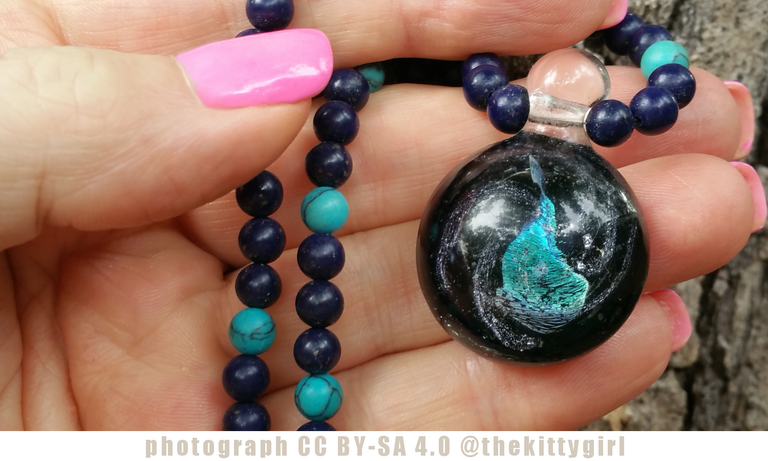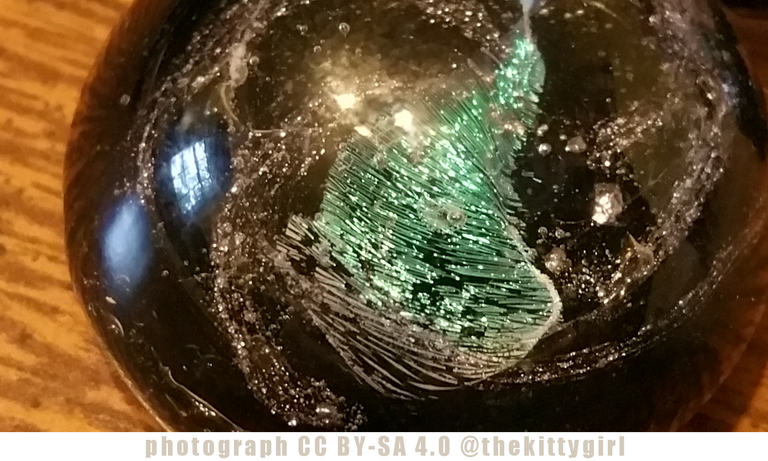I mentioned a mineral called aventurine in a recent post, then another post featured a man-made material called goldstone (a.k.a.: aventurine glass). In a rather nice segue only interrupted by a singular #caturday post, this post will talk about another man-made material known as dichroic glass.
Years ago, I learned about dichroic glass when I visited a shop where I sometimes bought stones, crystals, and minerals to add to my collection. The shop had a glass case beside the cash register where they kept a stock of assorted jewelry items for sale. In amongst the various pendants, rings, and bracelets, I saw an odd item that didn't really look like it was made of stone or metal so I asked about it.
The shop keeper gave me a brief education about dichroic glass while allowing me to hold and examine the item. It was little piece of glass that had an opaque, flat back and a convex dome (similar to a cabochon). A thin film of dichroic material was deposited inside during manufacture which reflected light in a delightfully iridescent manner! I was fascinated!
That piece of glass went home with me that day, partly because of the curiosity of it, partly because it was pretty, and partly because it was fashioned to be worn as a pendant (so it had a purpose). It was so long ago (early 2000s) when I bought it that I forget what the price was, but I don't think it was more than USD $10–$15 and I thought that fair for a little piece of wearable "art."
In my jewelry-making supplies at home, I already had a lovely string of lapis lazuli beads and a few turquoise beads. Since the pendant had a lot of blue in it, I thought those would be the perfect match. So, I strung the beads onto some strong jewelry wire with the pendant in the center, then crimped the ends with my crimping tool, adding a lobster-claw clasp, and had a necklace of which I could be proud and enjoy wearing with blue outfits.

According to the Oxford English Dictionary, the word "dichroic" comes from the Greek dikhroos (from di- ‘twice’ + khrōs ‘color’) and gives the following definition:
showing different colours when viewed from different directions, or (more generally) having different absorption coefficients for light polarized in different directions [source]
"Absorption coefficients for light polarized in different directions" also includes the type of lighting conditions under which the piece is viewed. The following photo shows the dichroic glass pendant as it appears in natural light outdoors:

See the pretty blue iridescent flash in the dichroic film? Now, the same pendant as viewed indoors under incandescent light just a few minutes after the above photo was snapped caused the dichroism to change to a green iridescence. That is dichroism at work!

The principles of dichroism fall under the umbrella of "thin film optics." Archaeologists discovered cup from the 4th century C.E. known as the Lycurgus cup which has a completely different color if the light is coming from behind it rather than in front of it. The effect is attributable to the presence of trace amounts of silver and gold in the molten glass when it was made. It's possible that this was an accident, as the trace amounts are so very tiny and no other such objects have been found from this time period.
Modern dichroic glass, however, was invented by NASA in the 1950s and 1960s for manufacture of special filters that they needed. In that more modern technique, trace amounts of metals are actually vaporized and then deposited in a thin film onto glass.
For a cheap little piece of 'art' such as I have, I am sure a more rustic technique was used, probably a bit more akin to what was used when the aforementioned Lycurgus cup was made, but without expensive silver and gold. I can't help but wonder what was used, though... 🤔 I will never know, as this appears to have been a one-off, unique piece, or perhaps part of a small, hand-made batch, nothing more. But, it's still pretty!
Dichroic glass has been used in architecture as well as art, as exhibited in the Doppler Building in Seattle, Washington state (US). The scientific uses include, but are not limited to:
Dichroic glass is used in various dichroic optical filters to select narrow bands of spectral colors, for example in fluorescence microscopy, LCD projectors, or 3D movies. [5]
Without NASA's research, we might not have 3D movies, LCD projectors, and one of the more comprehensive forms of microscopy as we do today.
Here is a closeup of the iridescence:

Below is one last shot, under bright incandescent light at my kitchen table. Strange, but even the turquoise beads even appear to have a bit of a dichroic effect to them under this light. The slight difference in color is also quite noticeable if one compares the two photos, above, where I am holding the necklace in my hand outdoors versus indoors. Granted, all turquoise varies between shades of blue and green, depending on quality and the area of the world from which it was mined. However, I've never heard of one piece changing colors when moved from natural to artificial light. Then again, I am not a licensed geologist. 😉
I might have to research that further and learn whether turquoise ever displays any dichroism, or if this is just a trick of the particular lighting in my house. A cursory search of several sites revealed no notable dichroism in turquoise but I might do more research before featuring turquoise in its own post at some future point — and yes, it is on my radar, along with many more of the pieces in my collection!

If you've stuck with me all the way through this post, you now know almost as much about dichroic glass as I do! Have any of you dear readers ever encountered this delightful material before? If so, tell us about it in the comments!
 😊
😊SOURCES
1 FireMountainGems.com: What is Dichroic Glass?
2 University of Delaware, College of Engineering: Dichroic Glass
3 NASA.gov Technical Reports Server: HIGH TECH ART- CHAMELEON GLASS
4 Wikipedia: Dichroism
5 Wikipedia: Dichroic Glass





to learn more about either of these projects, please visit: @heyhaveyamet or @theterminal

21-Jun-2020
View or trade
BEER.Hey @thekittygirl, here is a little bit of
BEERfrom @pixresteemer for you. Enjoy it!Learn how to earn FREE BEER each day by staking your
BEER.Kitty, I'm just wondering why there should be about the greek word from it's name?
By the way, why you don't it's more than 10 - 15 usd?
Ancient Greece was a center of learning and the Roman Empire conquered Greece and then spread learning over much of Europe. From there, the English language formed, so many of our words have roots in Latin and Greek.
The 10–15 USD is what I think I paid, but my memory is not clear from so long ago! 😬 LOL
The dichroic glass is so beautiful. I've not seen it before but I hope
to cross path with it someday.
Wow it very nice. I love it 😻
What beautiful jewelry & pieces. As a crystal lover, I have a small piece of aventurine in my collection. It actually is a healing crystal & is linked with the heart chakra. It helps calm negative emotions that become stuck in the heart space. It allows you to find that harmony & inner tranquility. Great for anxiety! 💚
Thanks for sharing this! 💗🙏🏻🧚
Wow it’s look beautiful I love that color
Congratulations @thekittygirl! You have completed the following achievement on the Hive blockchain and have been rewarded with new badge(s) :
You can view your badges on your board And compare to others on the Ranking
If you no longer want to receive notifications, reply to this comment with the word
STOPSupport the HiveBuzz project. Vote for our proposal!